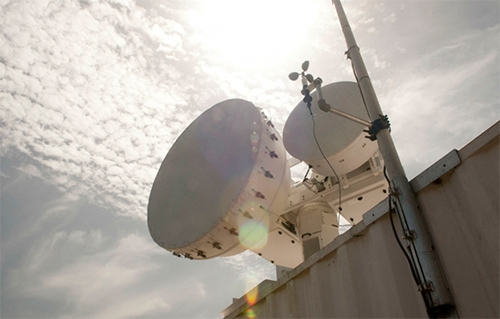

Instruments installed at the T3 site in Manacapuru, Amazonas, one of the areas in which the GOAmazon experiment was conducted (photo: Eduardo Cesar/Pesquisa FAPESP)
The change, evidenced in a study published in Nature Geoscience by researchers working for the Green Ocean Amazon experiment, impairs cloud formation and bioavailability of forest nutrients
The change, evidenced in a study published in Nature Geoscience by researchers working for the Green Ocean Amazon experiment, impairs cloud formation and bioavailability of forest nutrients

Instruments installed at the T3 site in Manacapuru, Amazonas, one of the areas in which the GOAmazon experiment was conducted (photo: Eduardo Cesar/Pesquisa FAPESP)
By Karina Toledo | Agência FAPESP – A study published in the journal Nature Geoscience on December 7 shows that pollution from Manaus, the capital of Amazonas State in Brazil, changes the physical properties of the particles in the atmosphere over the Amazon rainforest, increasing the proportion of solid particulate matter even when relative humidity is high.
“This change in particle state hinders cloud formation and reduces the bioavailability of nutrients essential for the forest to function, such as phosphorus, calcium, sulfur and nitrogen,” said Paulo Artaxo, a professor at the University of São Paulo’s Physics Institute (IF-USP) and one of the article’s authors.
The investigation was conducted by a group of researchers from Brazil, Canada and the US who belong to Green Ocean Amazon (GOAmazon), a scientific experiment supported by FAPESP, the US Department of Energy (DoE), the Amazonas State Research Foundation (FAPEAM), and other partners.
According to Artaxo, the study set out to determine whether the particles in suspension over the forest were predominantly liquid or solid because their state influences the dynamics of the atmospheric processes that take place in the entire Amazon region.
“The chemical reactions in gas exchanges between atmosphere and forest are much faster, stronger and more intense when the particles are liquid,” he explained. “The critical nutrients for the plants’ biogeochemical cycle return to the ecosystem more quickly when they're in soluble form.”
The results show that under natural conditions almost 100% of atmospheric particles are in a liquid state when relative humidity is above 80%. This helps explain why the hydrologic cycle is so intense in the Amazon.
“Liquid particles function far more efficiently as cloud condensation nuclei,” Artaxo said. “The droplets expand rapidly and soon acquire sufficient mass to precipitate.”
In the presence of pollution, however, the proportion of liquid particles in the atmosphere falls to 60%, even when the relative humidity is over 80%.
Counting particles
To reach these conclusions, the researchers performed measurements at two experimental sites monitored by GOAmazon. One site, referred to in the study as T0z, is a pollution-free area 50 km north of Manaus, where one of the project’s tower observatories is located. The other, T3, is near the town of Manacapuru, 60 km west of Manaus. The town is frequently affected by pollution from the capital, but the site is located in a pristine atmosphere downwind of the Manaus pollution plume.
To count particles, the group used a hygroscopic (water-absorbing) impaction surface called an impactor. “We selected the particle size to be measured, in this case 100 nanometers, for example, and counted the number of particles before and after they collided with the impactor,” Artaxo said.
Liquid particles adhere to the impactor, whereas solid particles rebound and are collected on a second surface for measurement. “This rebound fraction was much higher at Manacapuru than T0z for high relative humidity,” he added.
To confirm that the difference was due to pollution from Manaus and not to local factors, the researchers measured particles again on a day when air masses were flowing into the area from the forest instead of the city. The results were very similar.
“The experiment clearly shows that the state of the particles before and after pollution is very different. When pollution is present, plants can’t make efficient use of the nutrients in the atmosphere, so these nutrients are lost to the ecosystem. This is most important, given that forest growth is limited by the availability of phosphorus, which plants can assimilate only in soluble form,” Artaxo said.
More than 100 researchers from different parts of the world participated in the GOAmazon campaign, which began in January 2014 and has just ended. They studied the effects of pollution and anthropic activities on atmospheric chemistry, cloud microphysics and other climate processes, as well as terrestrial ecosystems. The group’s final aim is to estimate the impact of urbanization on critical aspects of the Amazon’s ecosystem, including future changes in the radioactive balance, energy distribution, regional climate, cloud cycle, and global climate feedback (read more at agencia.fapesp.br/18803).
The article, “Sub-micrometer particulate matter is primarily in liquid form over Amazon rainforest” (doi: 10.1038/ngeo2599), can be read at www.nature.com/ngeo/journal/vaop/ncurrent/full/ngeo2599.html.
Republish
The Agency FAPESP licenses news via Creative Commons (CC-BY-NC-ND) so that they can be republished free of charge and in a simple way by other digital or printed vehicles. Agência FAPESP must be credited as the source of the content being republished and the name of the reporter (if any) must be attributed. Using the HMTL button below allows compliance with these rules, detailed in Digital Republishing Policy FAPESP.





